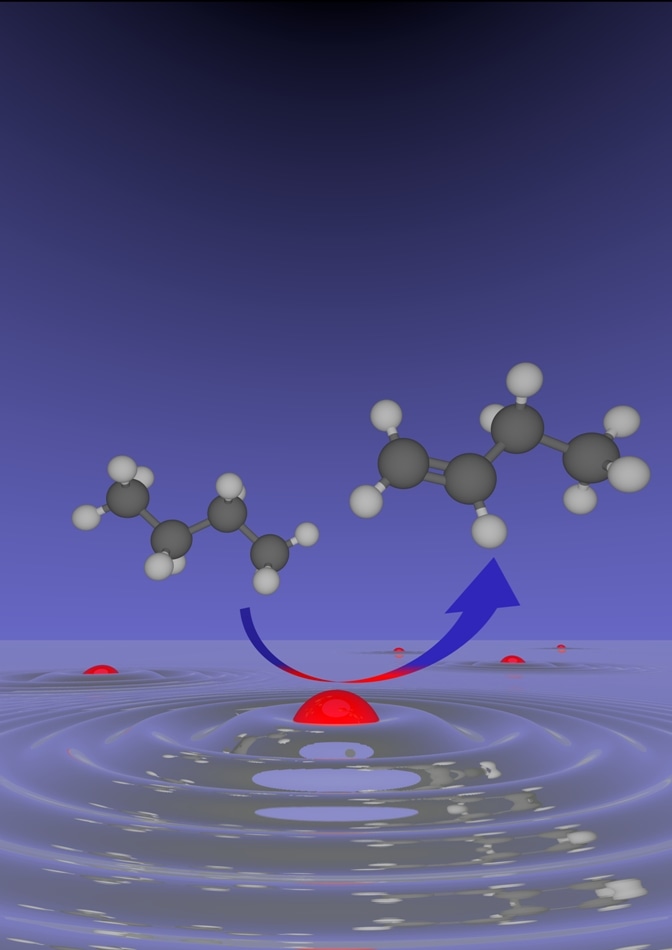Sep 15 2017
Catalysts can be defined as agents that initiate chemical reactions, speed them up or considerably increase the yield of the desired product. Therefore, innovative and improved catalysts are believed to be the key to making more efficient and sustainable production processes in the chemical industry.
 A diagram illustrating the processes at the catalytic surface of a liquid drop of gallium containing small amounts of palladium during the catalytic dehydrogenation of n-butane. (Image: FAU/Mathias Grabau and Florian Maier)
A diagram illustrating the processes at the catalytic surface of a liquid drop of gallium containing small amounts of palladium during the catalytic dehydrogenation of n-butane. (Image: FAU/Mathias Grabau and Florian Maier)
In a joint research project, five professors at Friedrich-Alexander-Universität Erlangen-Nürnberg (FAU) and their teams have recently discovered how to bypass the known challenges of the technical catalysts that are currently in use through a new material concept that leads to the creation of significantly more efficient catalysts.
This new generation of catalysts uses liquid drops of metal alloy attached to porous carriers that are brought into contact with the gaseous reactants. Since the microscopically small drops of alloy are fluid as they consist of a high proportion of gallium, an element with an extremely low melting point, the high concentration of gallium guarantees that the atoms of the dissolved secondary metal components are completely dispersed: the catalytic effect depends on the individual metal atoms in solution within the gallium. The researchers have published their results in the leading specialist journal Nature Chemistry (DOI: 10.1038/NCHEM.2822).
Supported liquid catalysts
Researchers at FAU have been able to repetitively show their international pre-eminence in the domain of catalyst material innovations for the past ten years. Therefore, Catalytic Materials is a research area of prime importance within the Cluster of Excellence Engineering of Advanced Materials (EAM) at FAU. For the FAU-based researchers, the focal point of interest is usually the supported liquid catalysts. These integrate the advantages of customized molecular reaction accelerators with the benefit that they can be more readily isolated from the product. The use of metal alloys in supported liquid catalysts is described for the first time in the concept outlined in the article published in Nature Chemistry. Furthermore, it is also the first time that catalytic activity has been attributed to liquid metal alloys.
In addition, the material combinations which were initially tested have proven to significantly outperform standard technical catalysts that have taken years to develop.
It is particularly interesting that there is little to no deactivation of the supported metal complexes when carbon deposits form on them. It is deposits such as this that are the main cause of the deactivation of catalysts used for catalytic conversion at high temperatures by the petrochemical industry.’
Professor Peter Wasserscheid
The researchers were able to show this essential effect in the case of the dehydration of butane. Four groups worked together and discovered the special structural nature of this new class of materials: Rainer Hock’s team was responsible for radiographic analysis, the teams of Hans-Peter Steinrück and Christian Papp finished the spectrographic analysis, and microscopic analysis was undertaken by Wolfgang Peukert’s team, while the corresponding calculations were undertaken by Andreas Görling and his colleagues.
Gallium: the secret of success
In this new class of materials, a major role is played by the element gallium, which has a boiling point of 2400 °C and melts at around 30 °C. Gallium possesses the unique ability of being able to dissolve roughly all other metals. Ultra-thin layers of oxide form on the surface of gallium when it is exposed to air. However, these are reconverted back to the original element under the conditions achieved during a number of catalytic processes. So far, spectacular results have been achieved by the FAU-based researchers by using palladium dissolved in gallium. They now aim to conduct further research to figure out if these astonishing effects can be achieved even when using non-precious metals dissolved in gallium and also if the effects can be reproduced in association with other chemical reactions. ‘Our calculations lead us to assume that single metal atoms dissolved in gallium can display totally different reactive characteristics from those that the same metal in crystalline form will usually exhibit,’ explains Andreas Görling. ‘This is why we are so fascinated by this new class of catalytic materials. We are convinced that with the help of supported alloy complexes, highly efficient and very cost-effective catalysts can be developed that have considerable potential with regard to industrial applications,’ adds Hans-Peter Steinrück.
The Cluster of Excellence EAM
Since 2007, the Cluster of Excellence EAM has been active in the research and development of new materials. The cluster has 200 staff working across nine disciplines, and will have received nearly €73 million in funding to the end of 2017. EAM has achieved major advances in the development of new high-performance materials in the fields of photonics, optics, nano-electronics, lightweight construction, and catalysis.